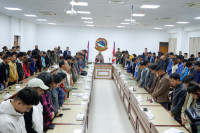Opinion
Fifty years of partnership
Despite all the good intentions, declarations and efforts, the last 50 years of the history of the world show a remarkably disappointing capacity to achieve economic growth while addressing inequalities and social inclusion.
Jose Assalino
Despite all the good intentions, declarations and efforts, the last 50 years of the history of the world show a remarkably disappointing capacity to achieve economic growth while addressing inequalities and social inclusion. Probably, even more disturbing is the evidence that when something seems to move in the right direction, governments are not able to maintain the momentum and tend to fall into models of development in which
economic growth comes coupled with increased inequalities. In the mid-20th century, when inequalities started narrowing in the more economically developed nations, analysts suggested that inequality would tend to decline in poorer countries too, as they develop and become richer.
Proving them wrong, in recent years, economic inequality has risen sharply in wealthy nations and has even grown in many poorer economies. This is a very prominent trend in the Asia-Pacific region, with the Gini coefficient increasing by 9.6 in China, 6.4 in Indonesia, and 3.1 in India, countries that together host about 40 percent of the world population. Similarly, inequalities are also on the rise in other countries of the region including Bangladesh, Sri Lanka, Loas, Mongolia and Vanuatu. Evidence shows that inequality is closely correlated with low growth, and more unequal societies tend to perform poorly on social indicators, compromising educational attainment and the generation of decent jobs, and hindering the establishment of enabling environments for sustainable development.
Listen first, talk second
Naturally, Nepal was affected by these global and regional adverse contexts, and the country has been struggling with critical challenges such as poverty, unemployment and underemployment that were further exacerbated in 2015 by the massive earthquakes and the border blockade. The economy is still weak, poorly diversified and heavily dependent on agriculture and remittances from Nepalis working abroad, and it has a relatively low industrial output.
However, at the same time, Nepal is also an amazing country that refuses to be defeated by difficulties, and that learned to view problems as opportunities. The Gini coefficient improved from 43.26 in 2003 to 32.75 in 2010, and the proportion of people living below the international poverty line has been cut by more than
half in a short period of time from 53 percent in 2003 to 23 percent in 2015. Enormous progress was also achieved on a number of critical social indicators such as education, health, gender empowerment, safe drinking water, and basic sanitation.
The International Labour Organisation’s (ILO) Nepal Country Office was established 50 years ago. During this period, the ILO has been working hand in hand with various government departments and national organisations. The main achievement of the ILO Nepal Country Office during this time was probably the development of a culture of open and truthful communication with constituents and partner institutions. The ILO Nepal adopted a “listen first, talk second approach”, which allowed it to understand the needs, plans and views of constituents and partners better, and to formulate considered responses without jumping to hasty conclusions. This has been the basis for the design and implementation of joint projects with constituents and
partners to address critical national challenges, and to identify opportunities for continuous improvement of policies, strategies and processes.
In these 50 years, 11 ILO International Conventions were ratified, demonstrating the commitment of Nepal to the promotion of social justice and a more inclusive society. This national commitment was supported by the Nepal Decent Work Country Programme and a myriad of ILO projects to prevent and eliminate forced labour, child labour, and trafficking of women and girls, improve social protection and occupational safety and health, address the informal economy, reform labour laws, advance indigenous peoples’ rights and promote employment, training, and safe migration.
At the same time, the ILO Nepal Country Office developed the clear understanding that projects do not change a country. Even when projects are labelled “big”, they tend to be too small and/or too short to transform people’s lives in a sustainable way, and to ensure significant and lasting impact at the macro level. Poor women and men need long-term support to allow them to rise above poverty and to gain the ability to dream for something better for them and their children. They don’t look for project offices established by international organisations they know vaguely, if at all. They look for national institutions with the right mandate to address their difficulties, those institutions that they may know, with whom they can communicate freely, and that will always be there for them.
Source of strength
Building the capacities of relevant national institutions is the answer. A project is only truly successful when it manages to establish structural partnerships with relevant national institutions and is able to build their capacities to create conditions for the continuation and gradual upgrading of activities beyond the project‘s lifespan. In this line, a substantive condition for the success of a project depends on its partners, their willingness, commitment, vision and aim to boost their own response capacity.
The strength of the ILO Nepal Country Office comes very much from its implementing partners. Government institutions such as the Ministry of Federal Affairs and Local Development, Ministry of Land Reform and Management, Ministry
of Agricultural Development, Ministry of Industry, Ministry of Peace and Reconstruction, and Ministry of Foreign Affairs have been contributing decisively for the success of their interventions executed in partnership with the ILO. They fully deserve the ILO’s acknowledgement and recognition.
However, and above all, the strength of the ILO Nepal Country Office comes from its constituents—the Ministry of Labour and Employment, the Federation of Nepalese Chambers of Commerce and Industry, the Nepal Trade Union Congress, the General Federation of Nepalese Trade Unions, and All Nepal Federation of Trade Unions. More than partners, they are the lighthouses that illuminate the path to follow. It is because of them that Nepal ratified the eleven ILO Conventions, and has some more in the pipeline for ratification, that it has prepared and approved a National Employment Policy and a National Occupational Safety and Health Policy, and that it has a new Labour Act and a new Social Security Act at final stages of endorsement by Parliament. And it is because of them that many Nepali workers have employment contracts, a minimum wage, defined working hours, defined leave days, paid leave, maternity protection, and health assistance. The ILO constituents are the true Nepali highways to social inclusion; as such, their role, importance and accomplishments need to be taught in schools.
Assalino is a former director of ILO Country Office for Nepal




 18.12°C Kathmandu
18.12°C Kathmandu










